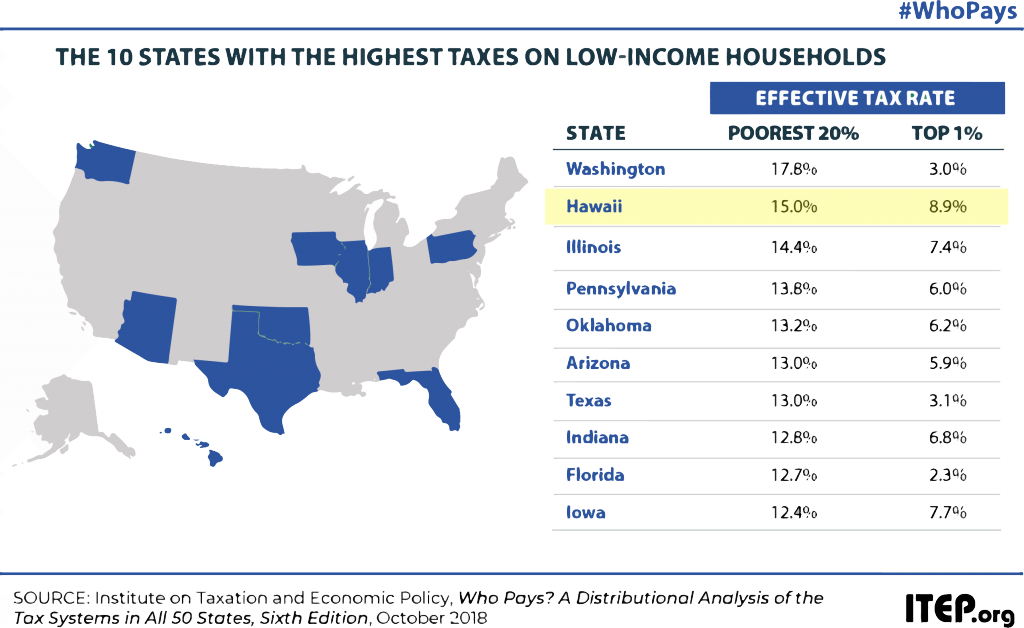STUDY: Hawai‘i’s Low-Income Taxpayers Carry 2nd Highest Tax Rate
A new study released on Wednesday, Oct. 17, 2018, by the Institute on Taxation and Economic Policy (ITEP), finds that the lowest-income Hawaiʻi residents pay 68% more in taxes, as a portion of their income, compared to the state’s wealthiest residents.
The study, Who Pays? A Distributional Analysis of the Tax Systems in All 50 States, analyzes tax systems in all 50 states. The analysis evaluates all major state and local taxes, including personal and corporate income taxes, property taxes, sales and other excise taxes.
The study finds that those in the bottom fifth of the income spectrum in Hawaiʻi pay 15% of their income in state and local taxes, while those in the top 1% pay only 8.9%, which exacerbates inequality in our state. At 15%, we have the nation’s second-highest state and local tax rate on people in poverty.
“Hawaiʻi has some of the highest housing costs in the nation, coupled with the lowest wages in the nation after factoring in cost of living. It does not make sense for us to pile on additional financial pressures with a high, inequitable tax burden on the residents who are struggling the most,” said Beth Giesting, director of the Hawaiʻi Budget and Policy Center. “Hawaiʻi is the kind of place where we all look out for each other. Reducing the high tax burden on low- and middle-earners and asking our wealthiest residents to do more is in keeping with our values.”
The poorest 20% of Hawaiʻi earners bring in an average of $10,200 per year (tying us for fifth-lowest with Mississippi) while the richest 1% bring in $948,200. That means that, before taxes, Hawaiʻi’s richest make 96 times more money per year than our poorest. However, the richest 1% do not pay 96 times more in taxes. Rather, they pay only 57 times more. As a result, after taxes, the gap between the richest and poorest grows from being 96 times more to 103 times more.
The main cause of the heavy tax burden on those making the least in Hawaiʻi is the General Excise Tax (GET). Families in the lowest fifth spend 10.5% of their meager incomes on the GET, while the top 1% spend only 1.2% of their large earnings. In other words, those at the bottom spend 8.75 times more of their income on the GET than do those at the top.
As the Who Pays? study shows, broad-based graduated personal income taxes are the most equitable way to raise revenue. Given that low-income people are paying 68% more of their income in taxes than the richest in Hawaiʻi, lawmakers should carefully weigh the distribution of their taxes, as measured by Who Pays?, when considering changes to the tax code.
There’s also a more practical reason for Hawaiʻi, and all states, to be concerned about regressive tax structures, according to ITEP. If the nation fails to address growing income inequality, states will have difficulty raising the revenue they need over time. The more income that goes to the wealthy (and the lower a state’s overall tax rate on the wealthy), the slower a state’s revenue grows over time.
“Rising income inequality is unconscionable, and it is certainly a problem that local, state and federal lawmakers should address,” said Meg Wiehe, deputy director of ITEP and an author of the study. “Regressive state tax systems didn’t cause the growing income divide, but they certainly exacerbate the problem. State lawmakers have control over how their tax systems are structured. They can and should enact more equitable tax policies that raise adequate revenue in a fair, sustainable way.”
Learn more Hawaiʻi-specific details about this analysis online.


















